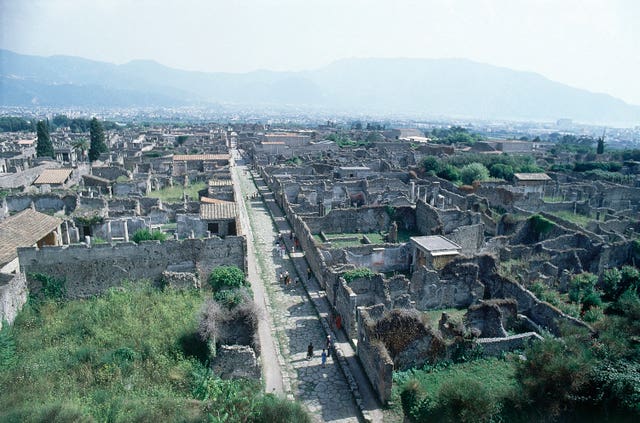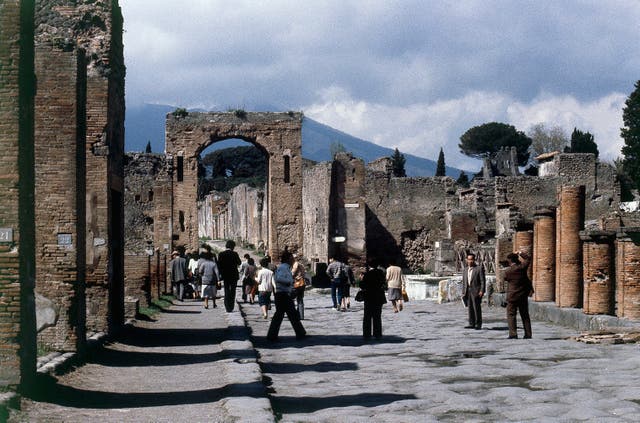
When a volcanic eruption buried the ancient city of Pompeii, the last desperate moments of its citizens were preserved in stone for centuries.
Observers see stories in the plaster casts later made of their bodies, like a mother holding a child and two women embracing as they die.
But new DNA evidence suggests things were not as they seem, and these prevailing interpretations come from looking at the ancient world through modern eyes.
“We were able to disprove or challenge some of the previous narratives built upon how these individuals were kind of found in relation to each other,” said Alissa Mittnik of the Max Planck Institute for Evolutionary Anthropology in Germany.

“It opens up different interpretations for who these people might have been.”
Ms Mittnik and her colleagues discovered that the person thought to be a mother was actually a man unrelated to the child.
And at least one of the two people locked in an embrace, long assumed to be sisters or a mother and daughter, was a man.
Their research was published on Thursday in the journal Current Biology.
The team, which also includes scientists from Harvard University and the University of Florence in Italy, relied on genetic material preserved for nearly two millennia.
After Mount Vesuvius erupted and destroyed the Roman city in 79 AD, bodies buried in mud and ash eventually decomposed, leaving spaces where they used to be. Casts were created from the voids in the late 1800s.

Researchers focused on 14 casts undergoing restoration, extracting DNA from the fragmented skeletal remains that mixed with them.
They hoped to determine the sex, ancestry and genetic relationships between the victims.
There were several surprises in “the house of the golden bracelet”, the dwelling where the assumed mother and child were found.
The adult wore an intricate piece of jewellery, for which the house was named, reinforcing the impression that the victim was a woman.
Nearby were the bodies of another adult and child thought to be the rest of their nuclear family.
DNA evidence showed the four were male and not related to one another, clearly showing “the story that was long spun around these individuals” was wrong, Ms Mittnik said.
Researchers also confirmed Pompeii citizens came from diverse backgrounds but mainly descended from eastern Mediterranean immigrants – underscoring a broad pattern of movement and cultural exchange in the Roman Empire.
Pompeii is about 150 miles from Rome.
The study builds upon research from 2022 when scientists sequenced the genome of a Pompeii victim for the first time and confirmed the possibility of retrieving ancient DNA from the human remains that still exist.
“They have a better overview of what’s happening in Pompeii because they analysed different samples,” said Gabriele Scorrano of the University of Rome Tor Vergata, a co-author of that research who was not involved in the current study.
“We actually had one genome, one sample, one shot.”
Though much remains to be learned, Mr Scorrano said, such genetic brushstrokes are slowly painting a truer picture of how people lived in the distant past.


Why are you making commenting on The Herald only available to subscribers?
It should have been a safe space for informed debate, somewhere for readers to discuss issues around the biggest stories of the day, but all too often the below the line comments on most websites have become bogged down by off-topic discussions and abuse.
heraldscotland.com is tackling this problem by allowing only subscribers to comment.
We are doing this to improve the experience for our loyal readers and we believe it will reduce the ability of trolls and troublemakers, who occasionally find their way onto our site, to abuse our journalists and readers. We also hope it will help the comments section fulfil its promise as a part of Scotland's conversation with itself.
We are lucky at The Herald. We are read by an informed, educated readership who can add their knowledge and insights to our stories.
That is invaluable.
We are making the subscriber-only change to support our valued readers, who tell us they don't want the site cluttered up with irrelevant comments, untruths and abuse.
In the past, the journalist’s job was to collect and distribute information to the audience. Technology means that readers can shape a discussion. We look forward to hearing from you on heraldscotland.com
Comments & Moderation
Readers’ comments: You are personally liable for the content of any comments you upload to this website, so please act responsibly. We do not pre-moderate or monitor readers’ comments appearing on our websites, but we do post-moderate in response to complaints we receive or otherwise when a potential problem comes to our attention. You can make a complaint by using the ‘report this post’ link . We may then apply our discretion under the user terms to amend or delete comments.
Post moderation is undertaken full-time 9am-6pm on weekdays, and on a part-time basis outwith those hours.
Read the rules here